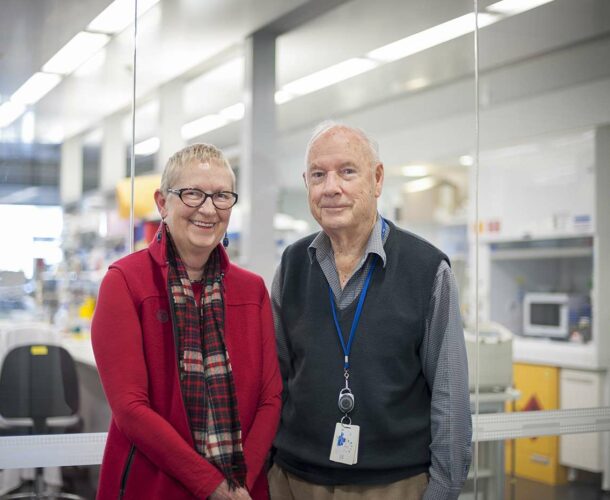CSFs stimulate white blood cells to be produced by the bone marrow, and provide life-saving protection against infection.
These people have used the drug, usually in the form of Neupogen (G-CSF), after a cancer diagnosis, to help them recover from the chemotherapy; as part of their own – or a donor’s – blood stem cell transplant; or as treatment for other chronic conditions, such as neutropenia.
Improving lives
Though Professor Donald Metcalf, who led the CSFs program for 30 years, was grateful to have been part of medical research that was improving – and even saving –lives, he did not dwell on self-gratification.
“I have a photograph of a young lad who is now able to deal with a disease in which his white cell production stops every 18 days, so infections occur. He now injects his G-CSF daily, just as a diabetic would inject insulin, and is essentially in normal health.
“It’s interesting; you do run into patients in the supermarket who say, ‘Oh, I have had CSF treatment.’ That is an uncommon thing to happen in medical research. Most research workers spend their life knowing that their work is not likely to have a direct impact on clinical medicine.”
In 2012, to coincide with the opening of the institute’s new building, more than 60 Victorians treated with CSFs joined us to meet Metcalf.
They also met a number of other members of the team behind the discovery of CSFs – Nick Nicola, Tony Burgess, Nick Gough and Ashley Dunn.
A long-term connection
One of the CSFs recipients attending that day was Ms Roz Edmond, whose connection with the Walter and Eliza Hall Institute long predates her birth in 1947.
It begins in 1934, when an uncommon woman of the era, Phyllis Rountree, a bacteriologist, arrives in Melbourne from Adelaide. She’d completed a Commonwealth scientific fellowship there but was farewelled with the explanation that “it was very nice having you here dear, but we don’t employ women permanently”.
So she walked off the street into the Hall Institute and asked the director, Sir Charles Kellaway, for a job. She was interviewed and hired by Dr Frank Macfarlane Burnet, who would go on to lead the institute and win a Nobel Prize for his work in immunology.
As a research assistant at the institute, she began investigating the bacteria staphylococci, which would become her area of specialty. On the recommendations of Burnet, she progressed to the London School of Hygiene and Tropical Medicine and a long and distinguished career, much of it at Sydney’s Royal Prince Alfred Hospital. There she was credited with groundbreaking work tracking ‘golden staph’, the mysterious killer that was the scourge of hospitals.
She never married, but sometime in those early Melbourne years she went on a blind date with a Scottish engineer, George Gillespie Edmond, just arrived in town with a brief to redevelop the Dunlop rubber factory. He was a bit fazed by her brilliance. Romance didn’t blossom, but an enduring friendship did. Rountree became the godmother of his daughter, Roz, and the lifelong friend of his wife and widow Arabelle.
“Magic shot in the guts”
Fast-forward to 2012, and Roz Edmond spots a small advertisement in The Age inviting people with a connection to the Walter and Eliza Hall Institute’s work to get in touch with the institute and share their stories. By then her connection ran deeper than her godmother’s history.
“I’d had breast cancer,” Edmond says, “and after every chemotherapy session I was being given CSFs.”
The semi-retired freelance editor is one of the millions of cancer patients around the world to survive the rigors of chemotherapy thanks to what she describes as “Donald Metcalf’s magic shot in the guts. After chemotherapy murders your system (damaging the bone marrow), CSFs kick-start your white blood cells”.
After calling the number advertised in The Age, Edmond was invited to morning tea at the institute, embarking on her own relationship with the institute as a supporter and donor.
She met Metcalf, who continued to work at the Walter and Eliza Hall Institute until his death in December 2014, aged 85. She visited his laboratory, thanked him for the work that had underwritten her recovery, and showed him an old photograph of her godmother. He recalled meeting her as a young researcher – she rather terrified him.
Inspired to support the “buzz”
Edmond has become a regular at the institute, attending lunches and presentations. She loves the buzz of the place – “the laboratories, they’re just jumping”. She’s inspired by the interests and ambitions of the latest generation of institute scientists – particularly the young women, the successors of her beloved godmother, who died in 1997.
She’s contributed to various institute programs, including scholarships for young scientists, and has nominated the institute as a beneficiary in her will. “I don’t own a house and never will. But there will be an amount in my estate to go straight to the Walter and Eliza Hall Institute for them to do whatever they like in honour of the work done by Professor Donald Metcalf and Dr Phyllis Rountree.”
Philanthropy is in her blood, she’s proud to say. Her grandfather founded a scheme for Scottish migrants arriving in New Zealand, giving them seed money to establish themselves as sheep farmers. Once they were on their feet they donated back to the fund to support the next arrivals.
“I’m a donor because I can be, because it is important to support these young students, these post-docs who are bursting with ideas,” she says. Maybe one of them will, like Donald Metcalf, change the world.
“I have great respect for bacteria and viruses – I got that from Phyllis. And I have a great deal of respect and love for people who put their brains to work in medical research, and who love what they are doing.”






